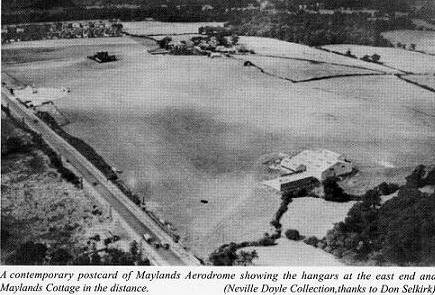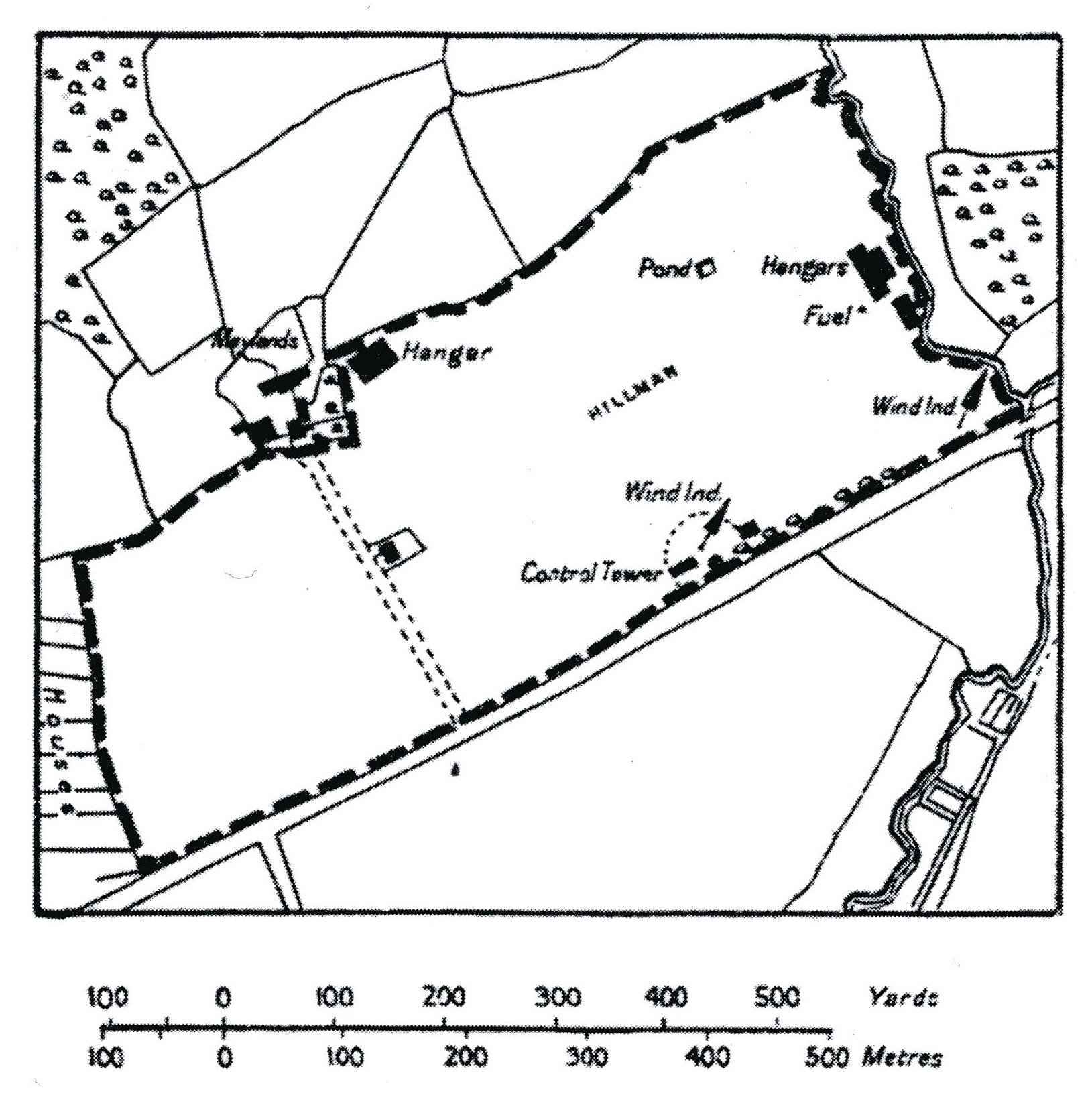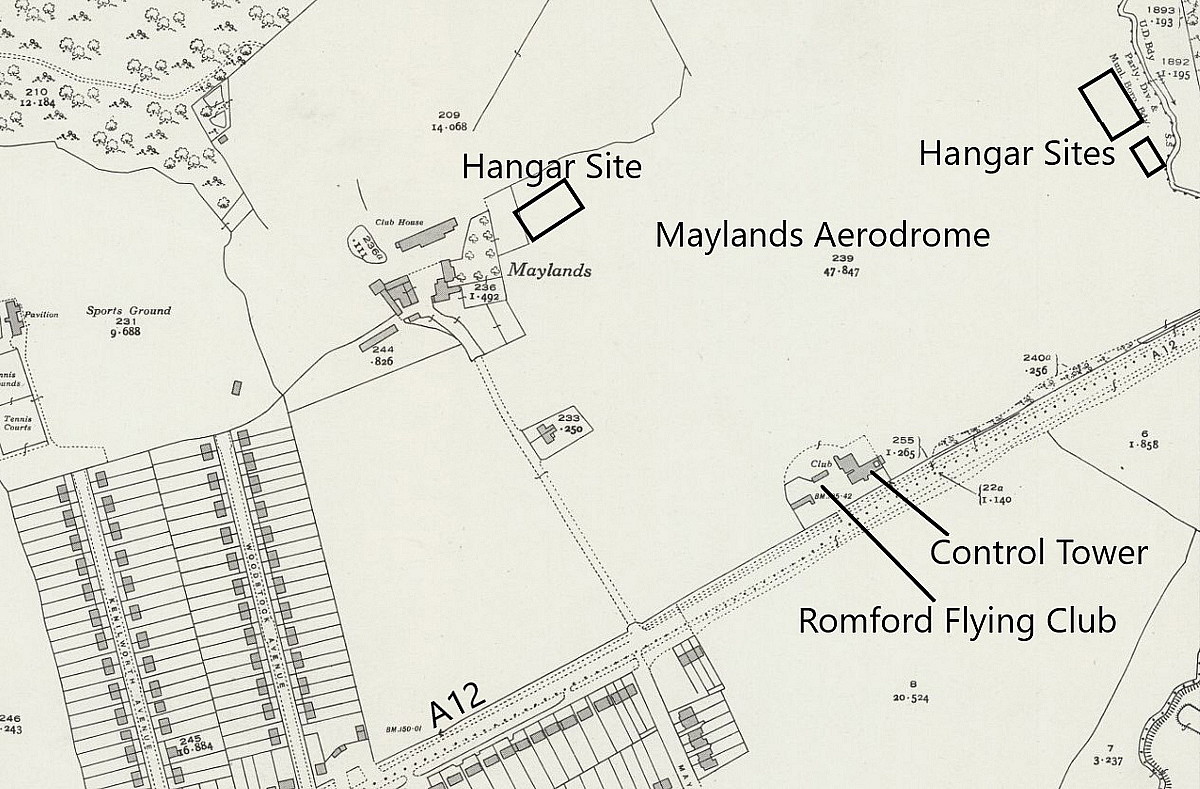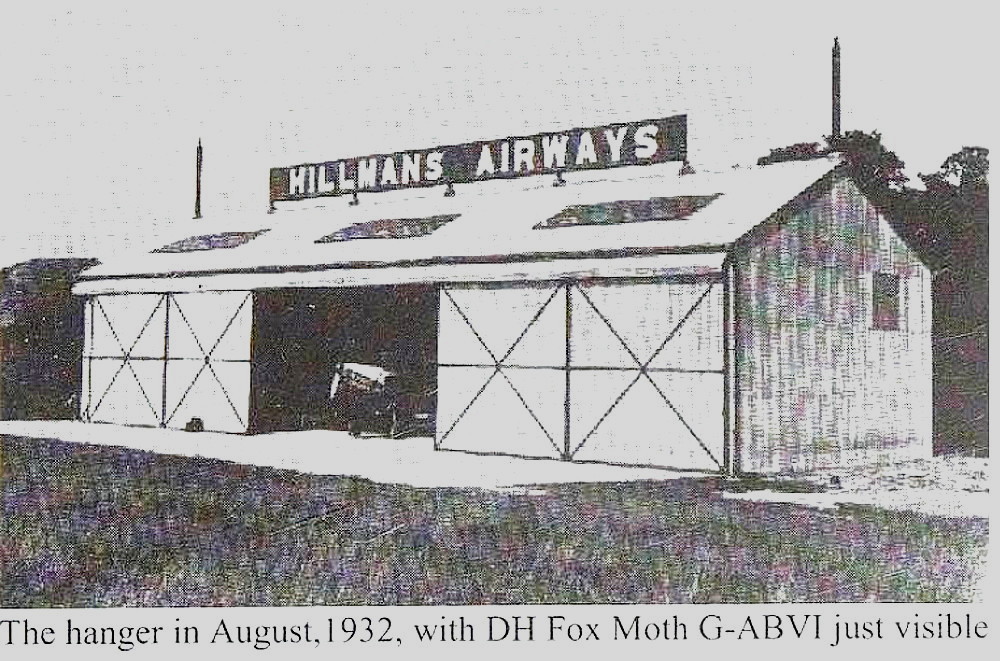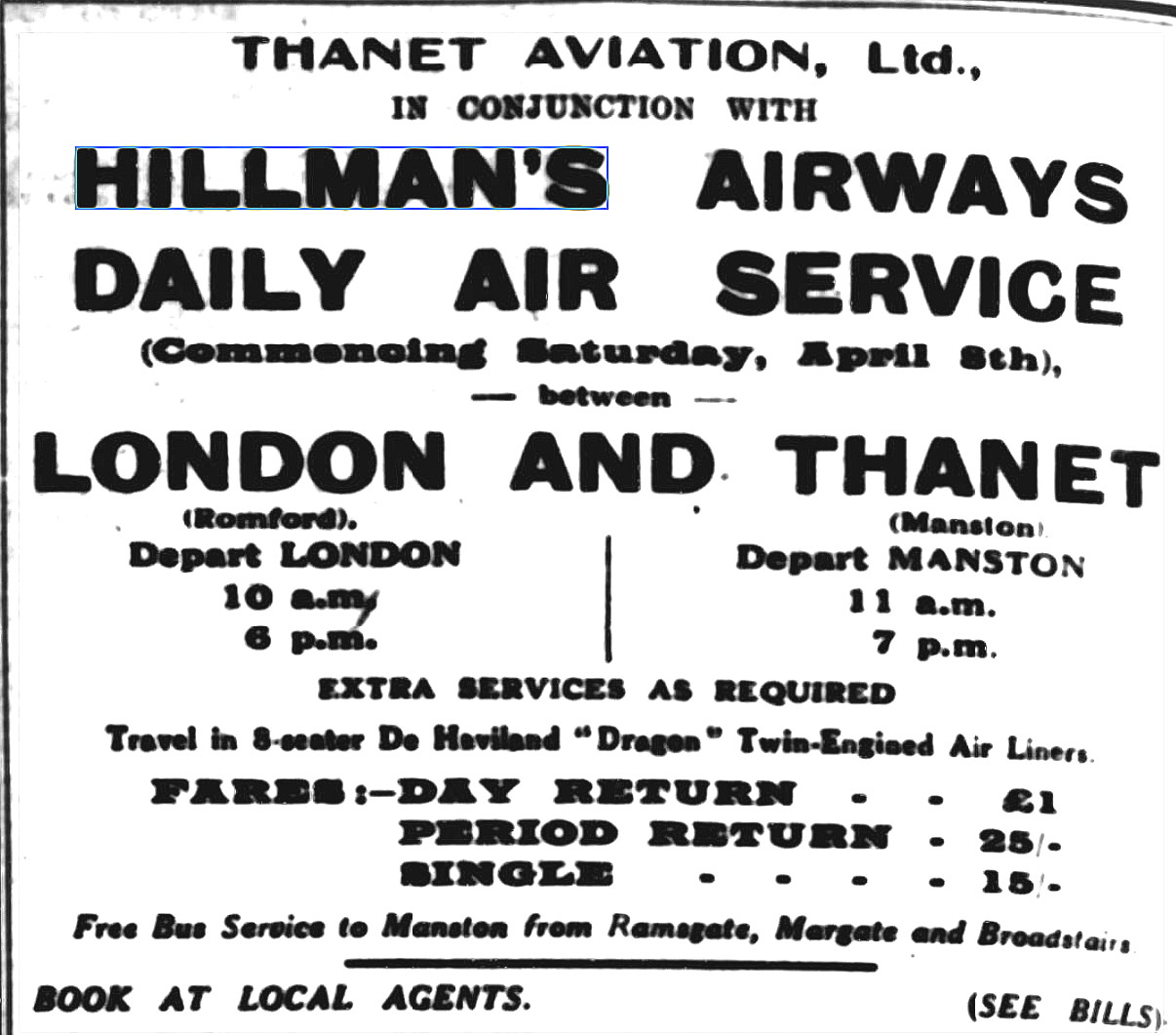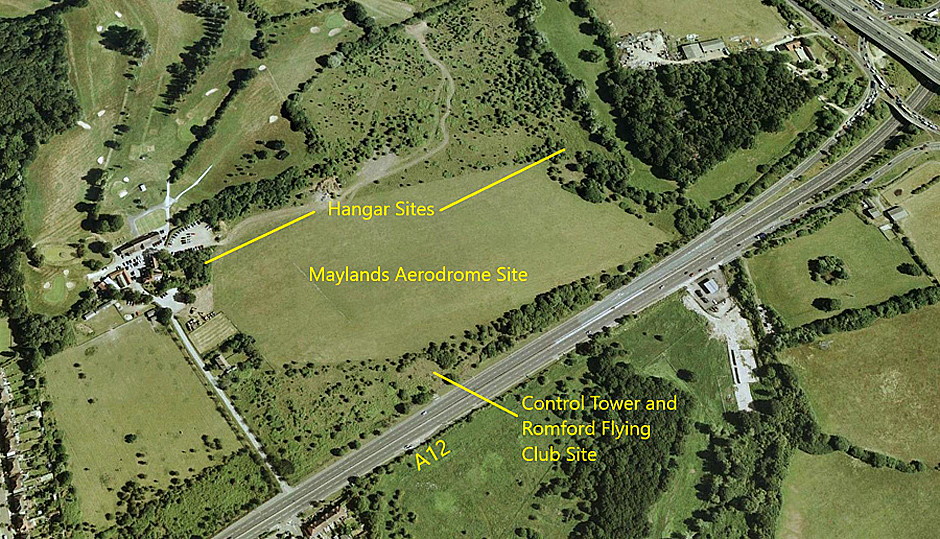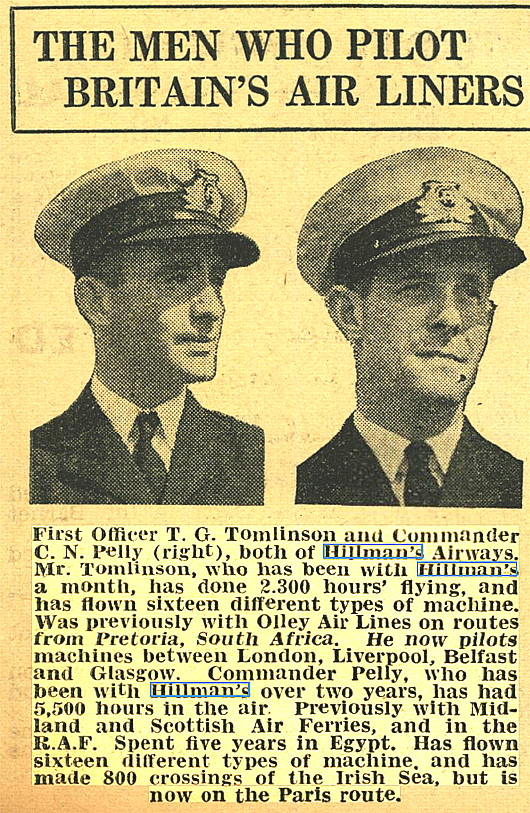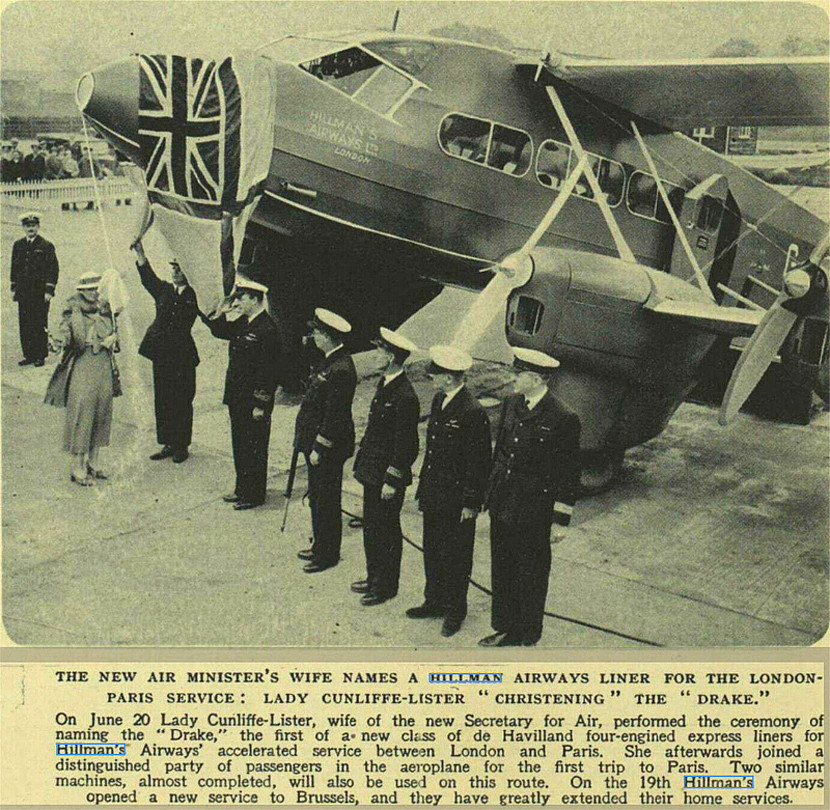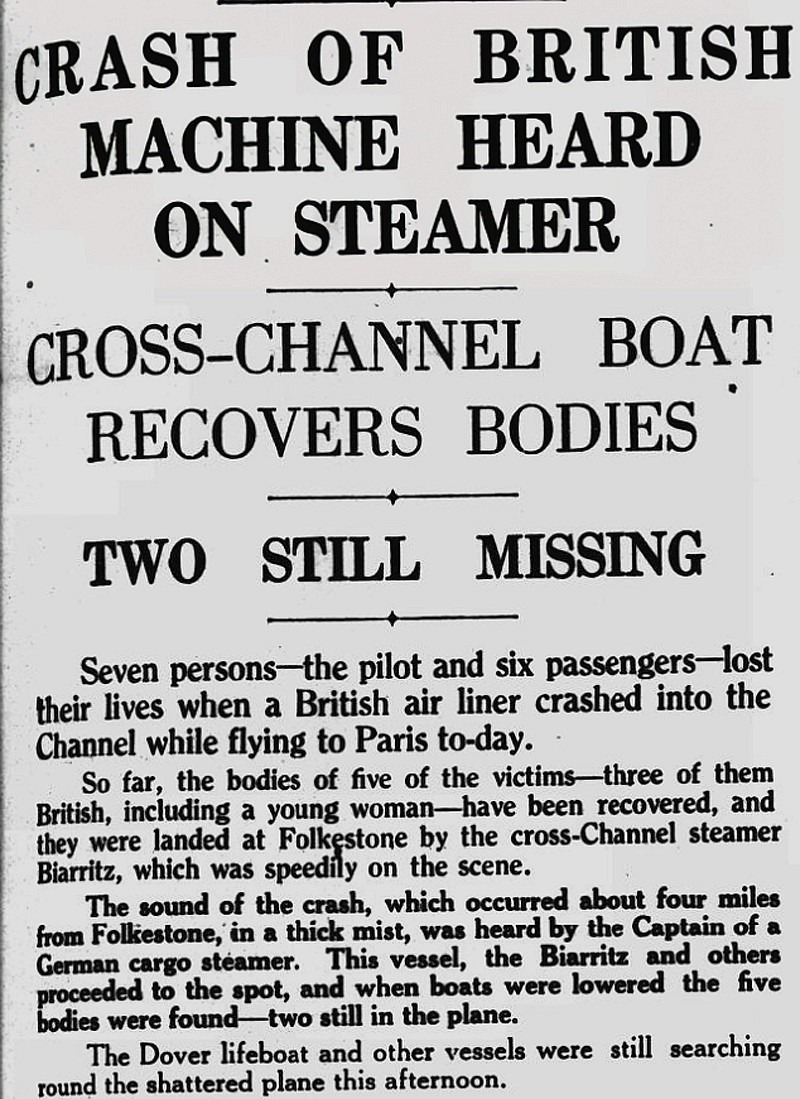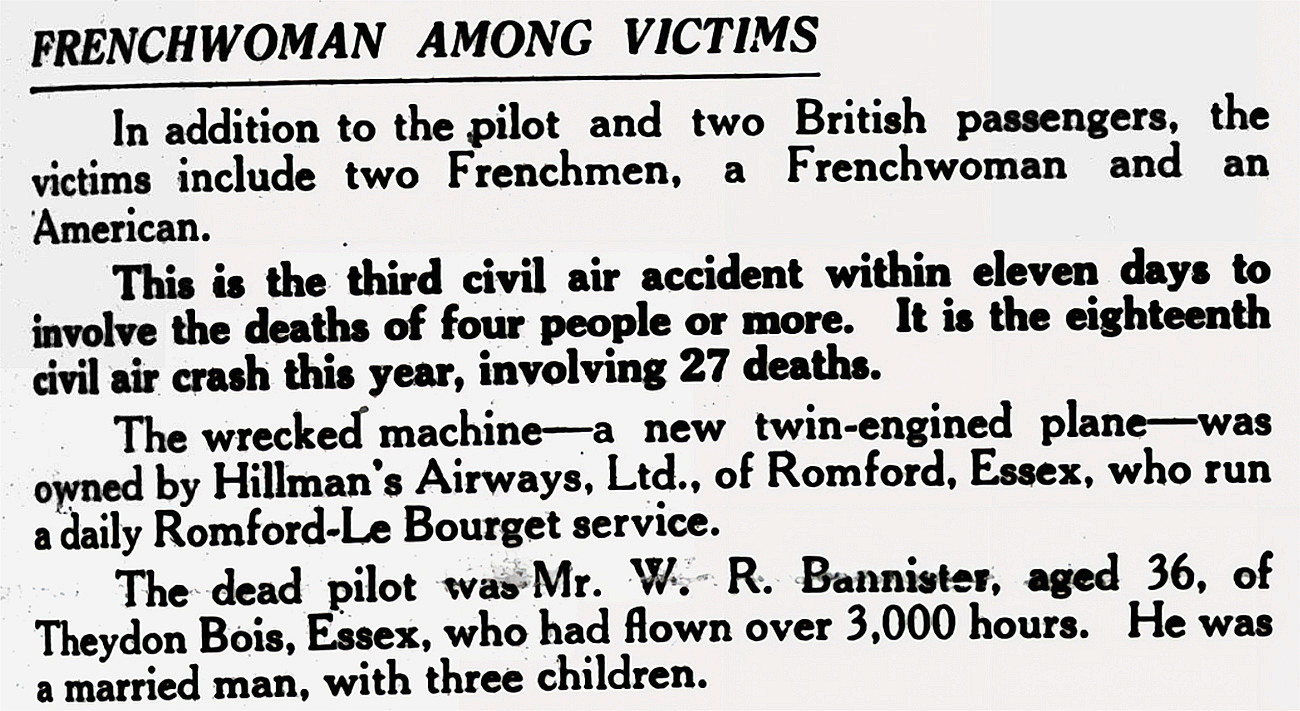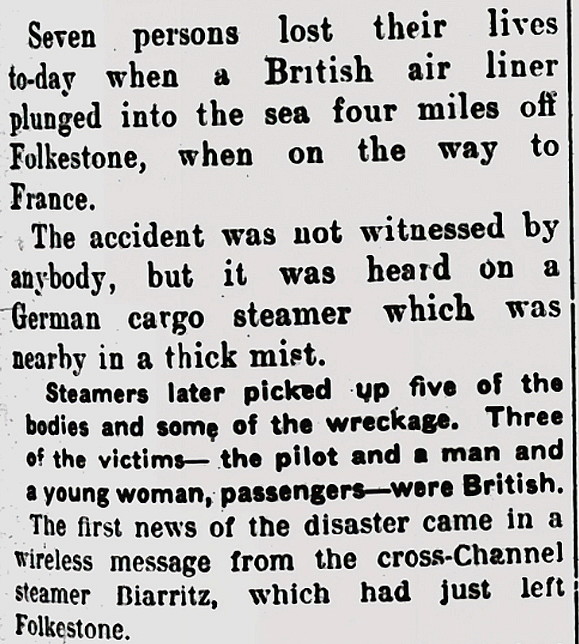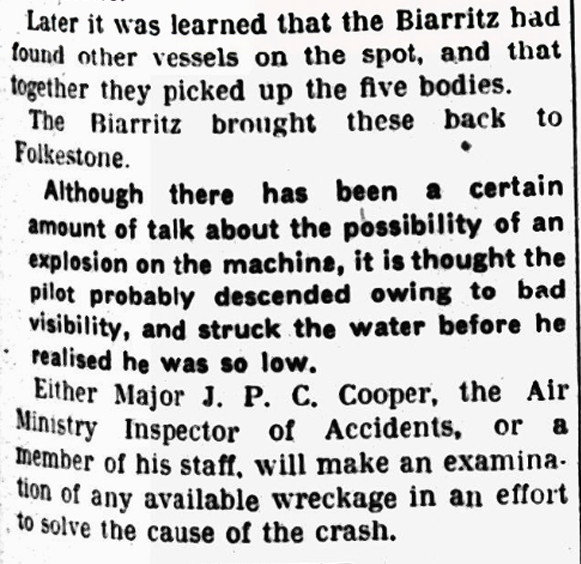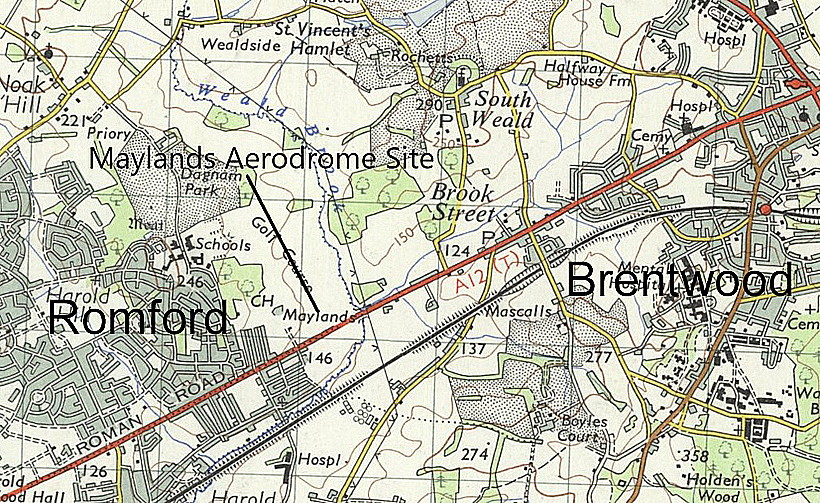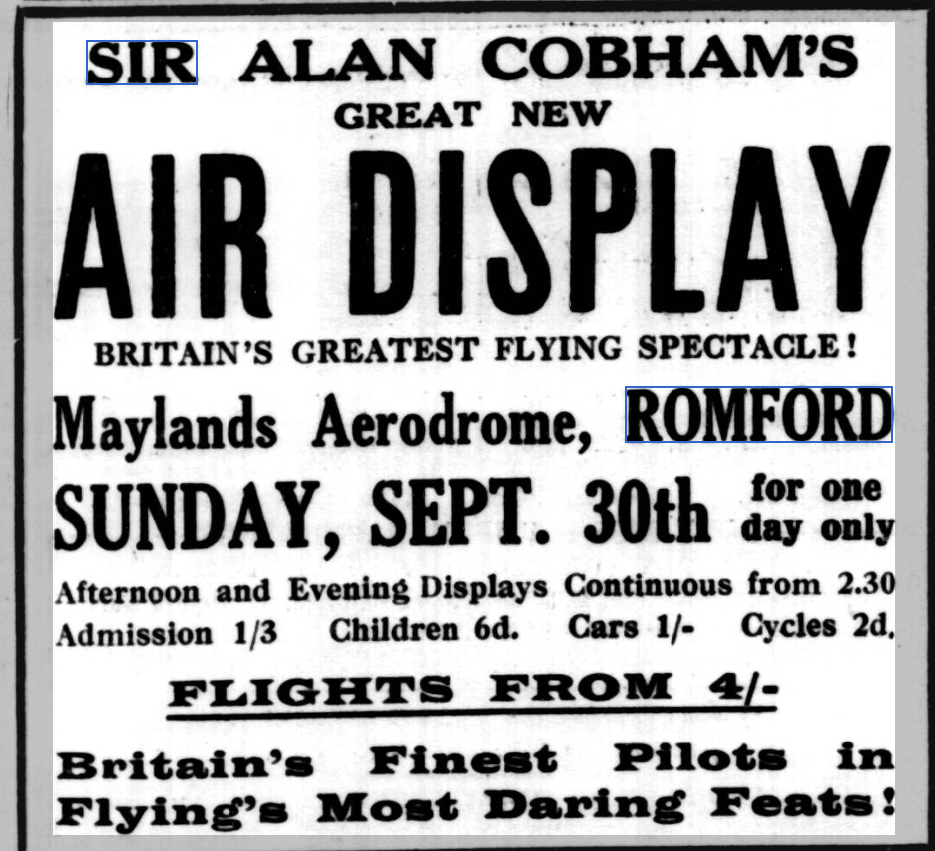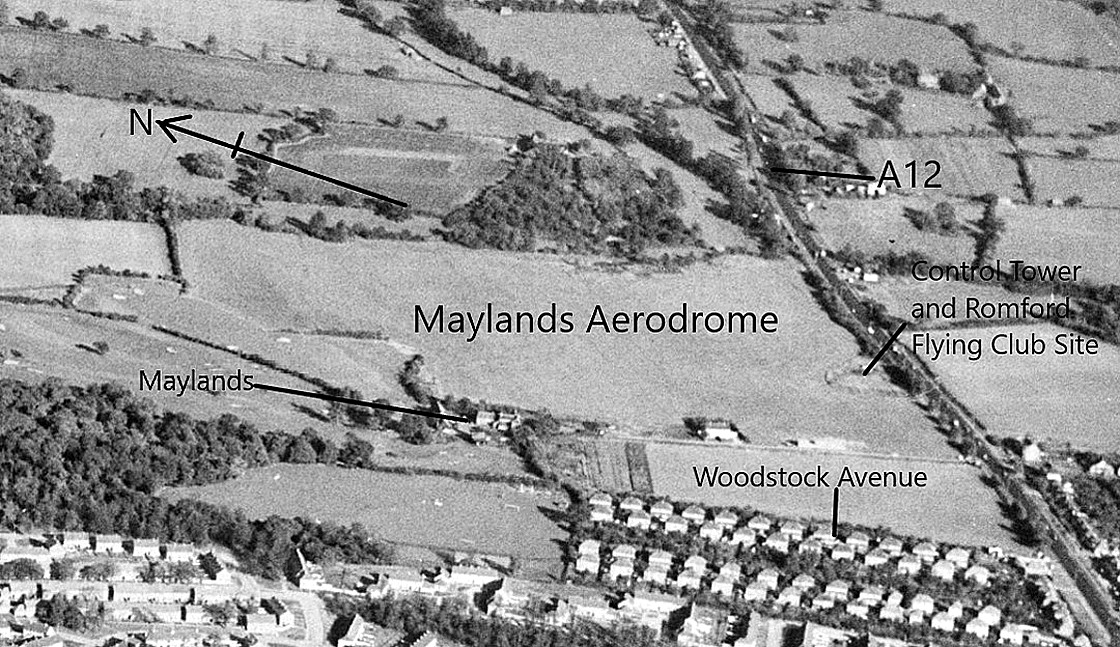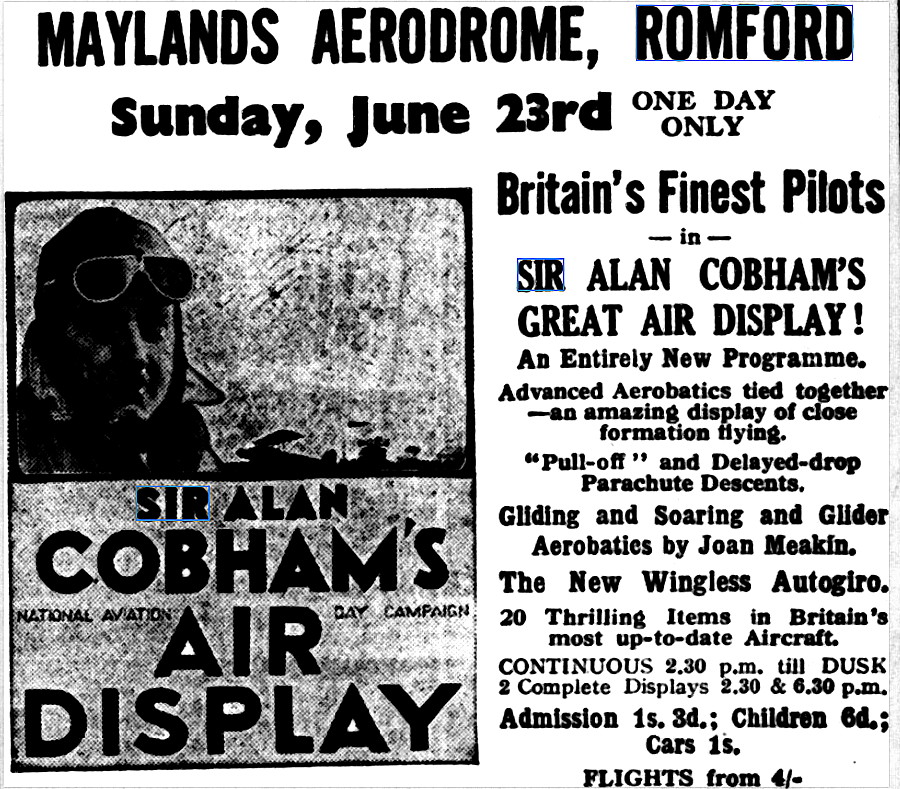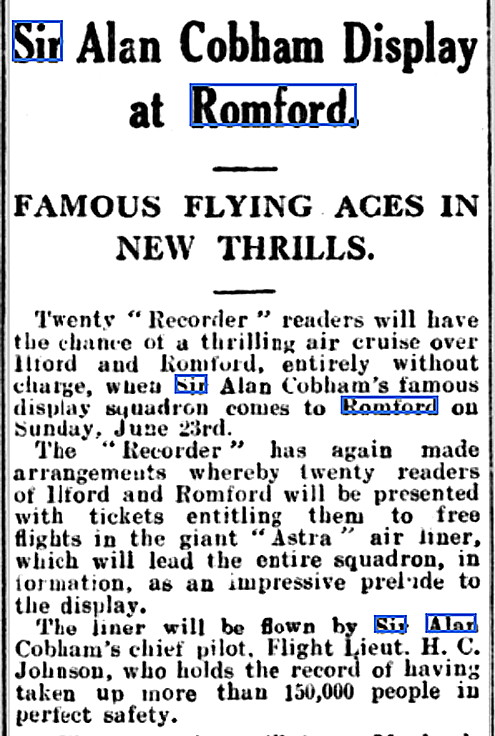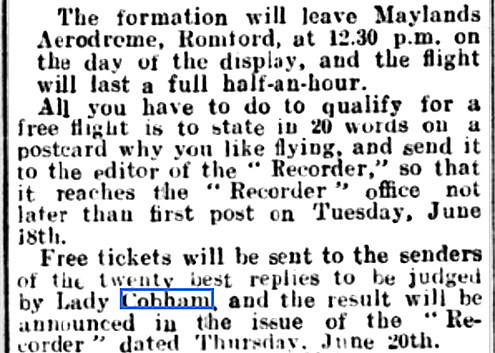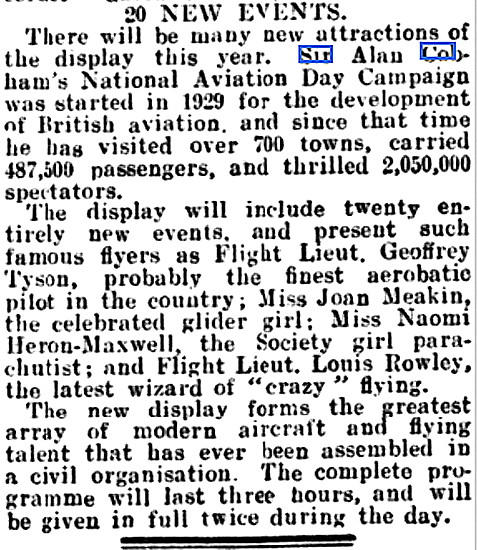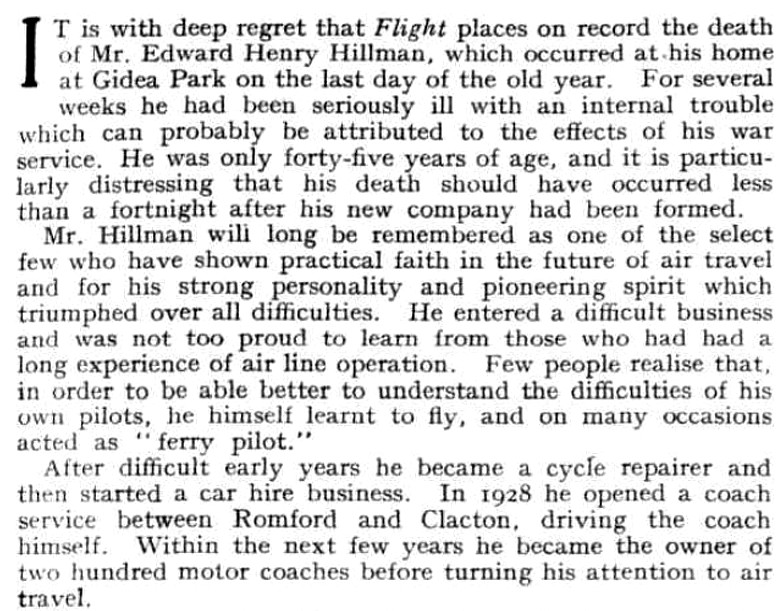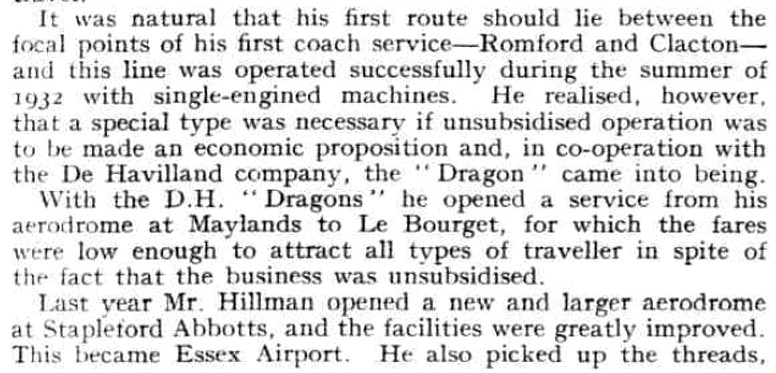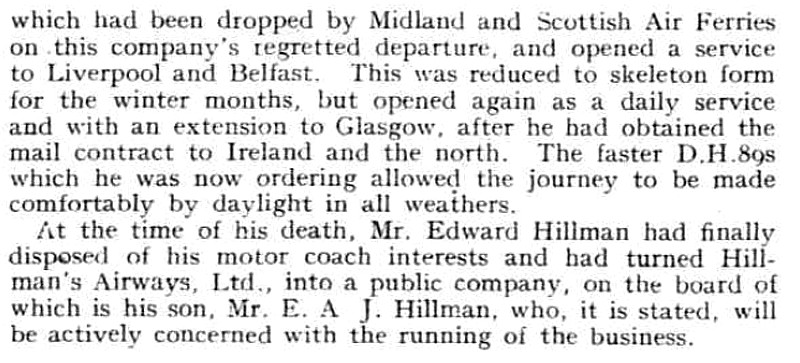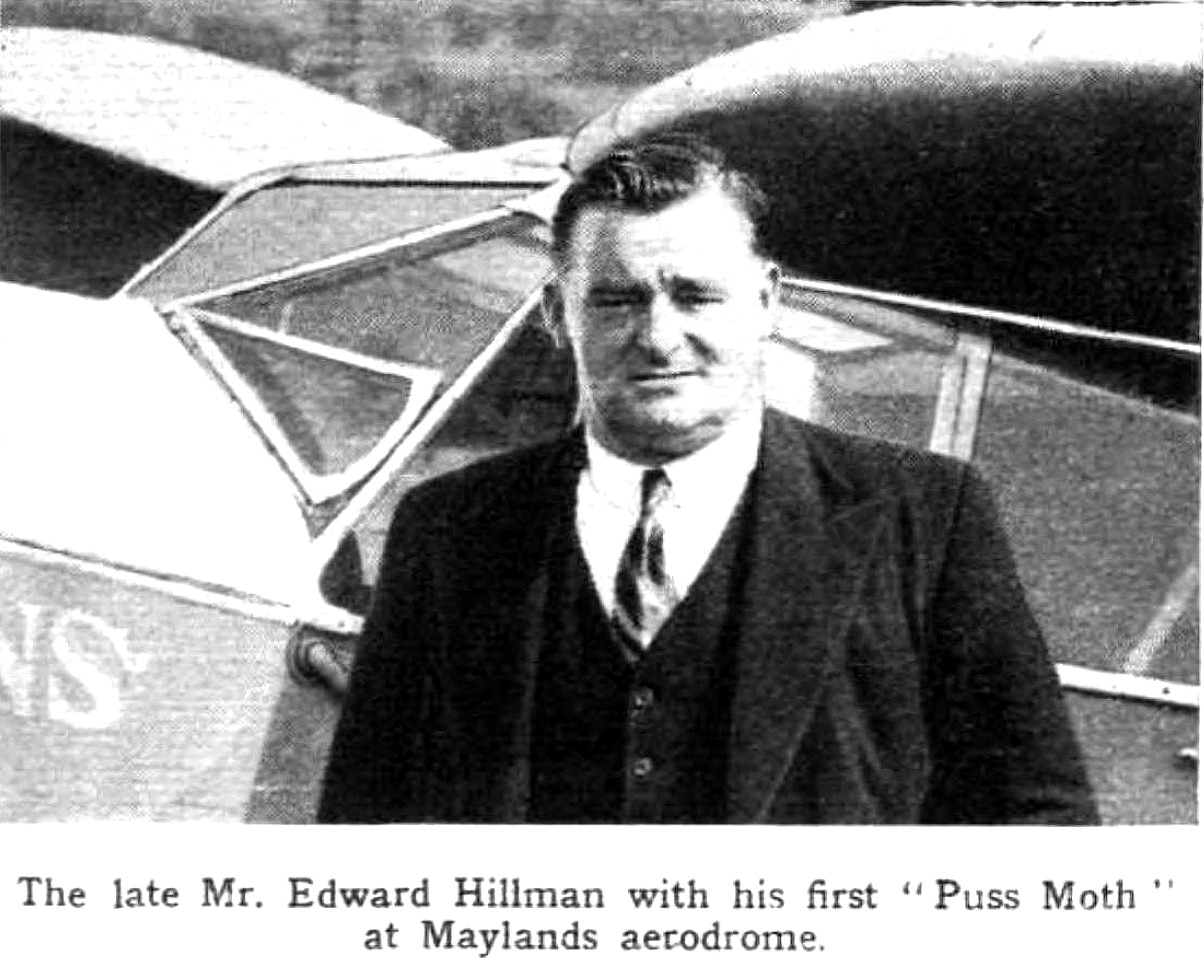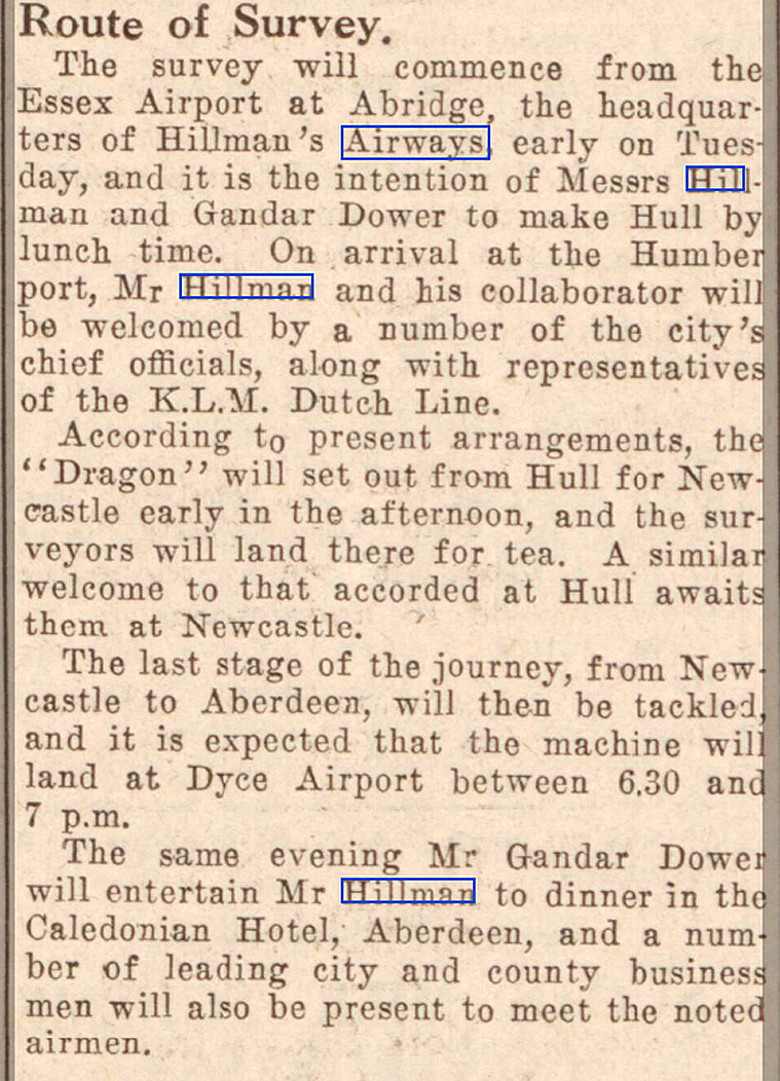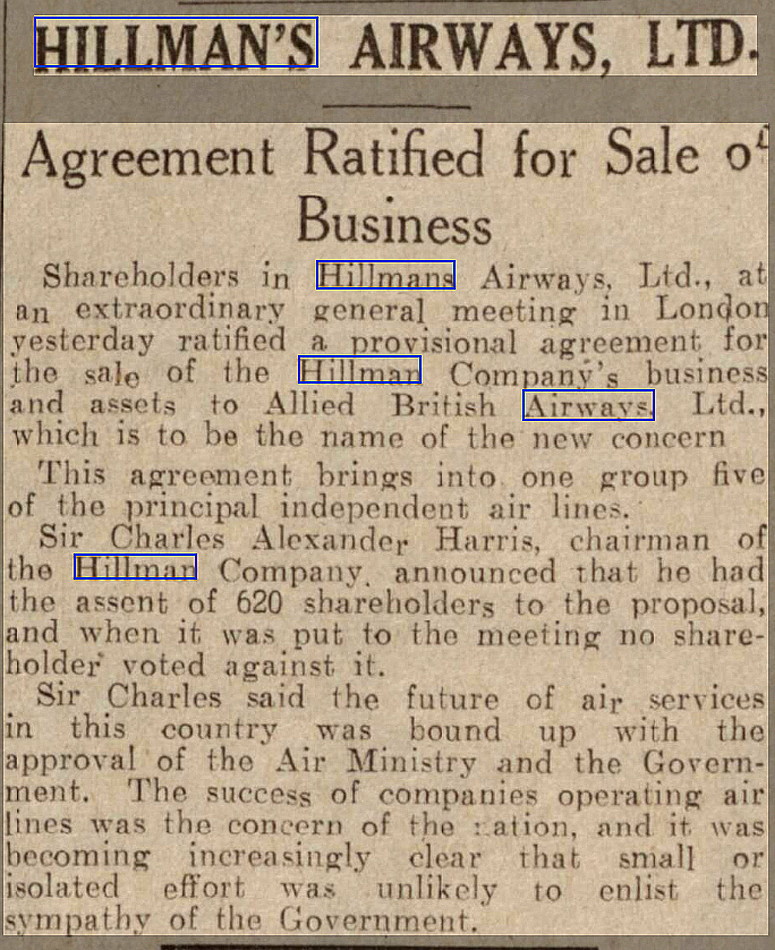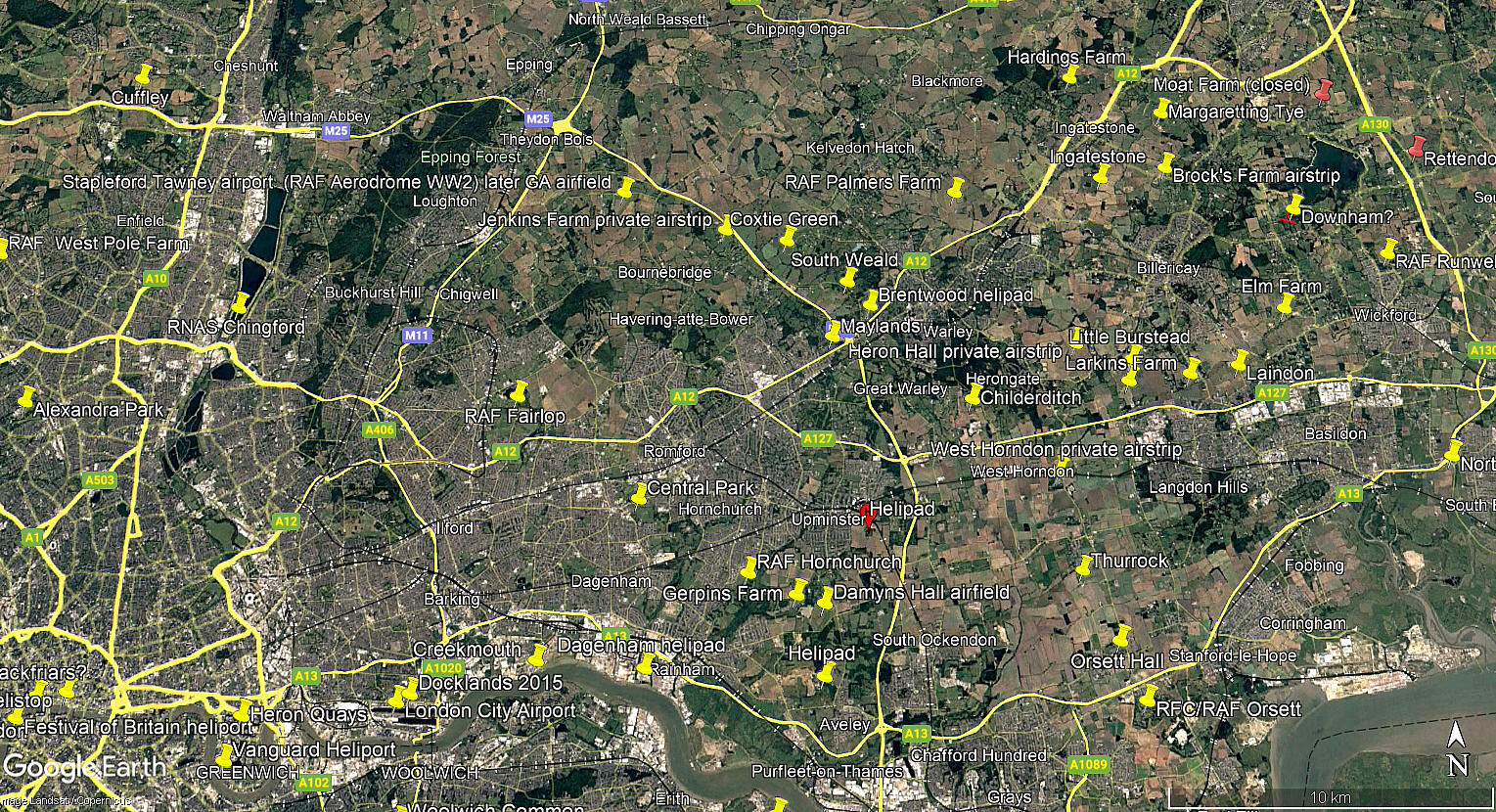Maylands
MAYLANDS: Civil regional airport later aerodrome
(Also known as ROMFORD, MAYLANDS FARM and ESSEX AIRPORT)
Note: Neville Doyle collection, thanks to Don Selkirk.
Operated by: 1929 to 1931: Inland Flying and Motor Services
1931 to 1935: Hillman’s Airways
1935 to 1939: Romford Flying Club
British airline users: Hillman’s Airways, Midland and Scottish Air Ferries
Pleasure flights: British Flying & Motor Services, (1928), Inland Flying and Motor Services, (1929)
Flying club: Romford Flying Club
Maintenance: 1935: Hillman & Cross
Manufacturing: Premier Aircraft Construction Company Ltd
Location: Alongside the A.12 at Harold Park in/near Harold Wood, roughly 2.5nm NE of Romford town centre but closer to Brentwood
Period of operation: 1928 to 1940
Runways: It appears that when MAYLANDS was being operated by Inland Flying Services the licensed landing runs were:
1929: E/W 457 grass NE/SW 274 grass
Note: It seems a SE/NW landing run was also used but I cannot find the length. By todays standards these are very marginal ‘landing runs’, and now usually used by microlight aircraft. However, such is the pace of "progress" as in those days most light aircraft could easily cope - albiet that they didn't think to add a 30% 'safety factor.
1933: MAYLANDS had been enlarged:
NE/SW 777 grass SE/NW 334 grass
A MICHAEL T HOLDER GALLERY
We have Mike Holder, a great friend of this 'Guide', to thank for undertaking the research to see what exists in press items, pictures and extra maps etc.
Photo One, of the Hillman's first hangar, was obtained from Maylands Aerodrome by Anthony K Philpot. Advert One was placed in the East Kent Times and Mail on the 5th April 1933.
The Photos and caption were published in the Daily Mirror on the 12th August 1935. Advert Two was placed in the Weekly Dispatch (London) on the 20th May 1934. Photo and caption Two was published in the London Illustrated News on the 29th June 1935.
A TRAGIC CRASH IN THE ENGLISH CHANNEL
This article in four parts was published in the Staffordshire Sentinel on the 2nd October 1934.
Advert Three was placed in the Eastern Counties Times on the 27th September 1934.
SIR ALAN COBHAM ARRIVES WITH HIS NATIONAL AVIATION DAY 1935 TOUR
This advert and article in three parts was published in the Eastern Counties Times on the 13th June 1935.
EDWARD HENRY HILLMAN (19th March 1889 to 31st December 1934)
This article in four parts was published in Flight magazine on the 3rd January 1935.
THE NAME HILLMAN LIVED ON - BUT NOT FOR LONG
It seems fitting to add these two articles published in the Aberdeen Press and Journal on the 29th September 1934 and the 11th October 1935 respectively. By this time of course, the operation had already been moved to STAPLEFORD.
The area view is from my Google Earth © derived database. Please note that many locations listed in this 'Guide' are not marked on this database.
NOTES: Originally it appears that MAYLANDS was simply a site for Mr A H Matthews private Avro 504K (G-EBSJ) who traded as Essex Flying Services. He was soon joined on the site by British Flying and Motor Services, (later to become Inland Flying Services*), who gave flying displays and pleasure flights from numerous ‘small fields’ all over the County. They operated using two DH.6s (G-EBPN & G-EBVS) and the Avro 548 (G-EBPJ). Having become Inland Flying Services two Avro 504Ks were added to the fleet (G-AAFE and G-AAFT).
In those days it is said their chief competitor was the Brooklands School of Flying which sent two red Avro 548s to ‘work’ any lucrative pitch between ESSEX and the Wash area. It seems they lashed ladders, bedding and tents externally to their aircraft! There is also mention of another outfit, Romford Anglian Air Services, (presumably another joy-riding concern?), operating from this site – but I have yet to find out more.
*Inland Flying Services went on to eventually become Portsmouth, Southsea and Isle of Wight Aviation Ltd (PSIOW). What a mouthful. See APSE FARM (ISLE of WIGHT) for more info.
THE HILLMAN ERA
At the end of 1931, (or early 1932), Mr Edward Hillman who operated a local bus company formed Hillman’s Airways Ltd here with initially two DH.80A Puss Moths which operated a Romford – Clacton service from the 1st April 1932, later ordering the DH83 Fox Moth. By1932 Mr Hillman had enlarged MAYLANDS and staged the impressive Essex Air Pageant on the 24th September 1932. It now appears the “Essex Air Pageant” was actually the ‘Official Opening’ of MAYLANDS with a suitable amount of dignitaries and celebrities attending, the air display being watched by 20,000 members of the public.
Some of the ‘knobs’ arrived in the Spartan Cruiser G-ABTY piloted by Lt-Col Louis Strange from HESTON and the sheriffs and ladies flew with Harald Penrose in a Westland Wessex. These were escorted by five Wapitis of No.600 Squadron (presumably based at NORTHOLT?) and three Bulldogs of 54 Squadron. The highlights of the airshow were the Bulldogs and a display of the Hawker Fury by the Hawker test pilot P E G ‘Jerry’ Sayer. Perhaps another unintended ‘highlight’ was when Henry Vaughan hit telegraph wires alongside the A12 on an approach to land and ended up with his DH.60 Gipsy Moth G-ABXX severely bent as a result.
For me probably the best entertainment would have been after the fly-past of twenty-two different types of aircraft when some of the pilots decided to land uphill when others were landing downhill, and others were trying to take-off downhill into wind! There was of course no radio ATC and very probably no proper pre-flight display briefing in those days.
THE FOUNDING YEARS
In his book The Triple Alliance Neville Doyle gives a comprehensive history of Hillman’s Airways and how the founder, Edward Henry ‘Ted’ Hillman established and ran his bus and coach company. In today’s terms in the road transport industry he was a total ‘cowboy’ operation and treated his staff abysmally. Not at all unusual in those days and indeed, some agency drivers I have met who have worked for the Royal Mail and Parcelforce (for example) can claim – “Nothing has changed!” Being confronted with route scedules so unrealistic it is obviously the work of fools.
Neville Doyle states the name of the business was changed, on the 12th November 1931 to Hillman’s Saloon Coaches and Airways, not then a limited company. On the 26th November Hillman acquired the license for Maylands aerodrome and the following day he received his first aircraft, a DH.80A Puss Moth, G-ABSB. The second Puss Moth, G-ABSO; “…..arrived in time to start joy-riding on Sunday, December 28th 1931 when they took £50”. These aircraft were also available for charter.
As per always the story is convoluted, obscured and probably incomplete. However, Neville Doyle in his book The Triple Alliance seems to have the story sussed out. For example stating that, according to the Clacton Gazette of the 19th March 1932: “On Tuesday (15th) Mr E Hillman, the well-known motor-coach proprietor, arrived at Alton Park Flying Ground, Clacton in a De Havilland Gipsy III Puss Moth, to complete the final arrangements”. The MAYLANDS to ALTON PARK/PLOUGH CORNER (Clacton) service was inaugurated on the Ist April 1932.
SPREADING HIS WINGS
Again according to Neville Doyle ‘Ted’ Hillman had learnt to fly by mid 1932 by Harold Wood, (the first pilot employed by Hillman in November 1931). What interests me is that Neville Doyle also states; “…Hillman machines on charter had been reported at Speke, Sunderland, Weymouth, Doncaster, Berck, Dublin, Waterford and Bournemouth.” Or should I say especially Weymouth. Where did they land? Weymouth appears an obvious candidate for having an aerodrome at this period but I have failed to find any evidence of one existing. It appears CHICKERELL was the probable landing site?
SOMETHING EXPLAINED?
Here is a very good example of how aviation history gets mashed up. After several years of research I had compiled these notes: “On the inauguration of the first DH.84 Dragon into service, (named Gidea Park some say**), which took place at MAYLANDS in early 1933, Amy Mollison (neé Johnson) was invited to attend as the ‘star turn’. Here’s the interesting bit (perhaps?) - as it appears that his pilots for this service were Nigel Pelly, Sammy Morton, ‘Timber’ Woods, and, it is often said - Amy Johnson! It now appears Amy Mollison only flew a few services for Hillman Airways during August and September 1934, by which time, (with demands outgrowing the facility at MAYLANDS), they’d already moved to STAPLEFORD TAWNEY in June 1934.
In 2012 I discovered the book The Triple Alliance by Neville Doyle and in my estimation nobody else has produced a more detailed and accurate history of Hillman’s Airways. There is of course a large element of trust involved in respecting authors accounts, but in this case I am much inclined to believe Neville Doyle.
It also now appears that Amy and Jim Mollison were invited, as ‘star turns’ to the Official Opening of MAYLANDS on the 24th September 1932. It then seems that Amy was invited on her own to ‘christen’ the first Hillman’s Airways DH.84 Dragon G-ACAN Maylands on the 20th December 1932. But it does seem the short period that Amy Mollison flew for Hillman’s Airways is more or less correct – see later for more details.
HILLMAN'S NAMED AIRCRAFT
**Having hopefully become an incipient ‘anorak’ and noticing the Gidea Park error, I decided to look up the ‘names’ of Hillman’s Airways aircraft. It turned out that ‘Ted’ Hillman had a penchant for naming some of his aircraft, starting with his six children, after which he reverted to local place names. The first aircraft to arrive at MAYLANDS was the Puss Moth G-ABSB on the 27th November 1931.
G-ABSB DH.80A Puss Moth Sonny (Edward)
G-ABSO DH.80A Puss Moth Babs (Barbara)
G-ABVX DH.80A Puss Moth Gilford
G-ABVI DH.83 Fox Moth Chris
G-ABVK DH.83 Fox Moth Doreen
G-ACAN DH.84 Dragon Maylands
G-ACAO DH.84 Dragon Goodmayes
G-ACAP DH.84 Dragon Romford
G-ACBW DH.84 Dragon Gidea Park
G-ACEU DH.84 Dragon Brentwood
G-ACEV DH.84 Dragon Ilford
Those of you who take an interest in such matters will notice that only five of the fleet were named after Hillman’s children. One likely answer is that the Fox Moth G-ABVJ was going to be named “Douglas” but ‘VJ’ was diverted to Eastern Air Transport after the loss of their Puss Moth G-AAXL in May 1932. Eastern had a Fox Moth on order and by this time Hillman had already placed an order for the latest DH.84 Dragons. Indeed, it appears that two other Fox Moths, (G-ABWB and G-ABWF), originally ordered and registered to Hillman’s, and painted in Hillman’s colours, never saw service with Hillman’s and went to Scottish Motor Traction. The first Dragon, G-ACAN, was delivered on the 20th December 1932 and christened ‘Maylands’ by none other than Amy Mollison, nee Johnson.
HILLMAN'S AIRWAYS FLEET
Hillman’s Airways fleet at MAYLANDS from 1931 to 1934 included:
DH.60GIII Moth G-ACGX
DH.60M Gipsy Moth G-ABCW
DH.80A Puss Moths G-ABSB, G-ABSO & G-ABVX
DH.83 Fox Moths G-ABVI & G-ABVK
DH.84 Dragons G-ACAN, G-ACAO, G-ACAP, G-ACBW, G-ACEU & G-ACEV
The Puss Moth G-ABSB was the first aircraft purchased by Hillman Airways, followed by another, G-ABSO. The third aircraft purchased was the Gipsy Moth G-ABCW – perhaps an unlikely purchase as it could only carry one passenger? However, by April 1932 Hillman’s Airways were offering a charter or taxi service, “…to take you anywhere at any time at 6d per mile per machine – pilot’s expenses and landing fees extra”. A typically outlandish, extravagant and unrealistic claim and quite typical of ‘Ted’ Hillman’s ideas about conducting a business.
Also from The Triple Alliance: “Dublin seemed to be a popular destination for charters”. This reflects the huge influence the Irish then had, and still has, in the horse racing ‘world’ in both the gambling ‘industry’ and bloodstock market.
THE ARRIVAL OF THE DRAGONS
It is sometimes said that in and around this time he took delivery of six DH.84 Dragons “built to his specifications”*** and in April 1933 began a scheduled service to Paris. As noted above, the first Dragon G-ACAN entered service in December 1932. A twice daily Paris (Le Bourget) was inaugurated on the 1st April 1933 with Capt Harold Wood (chief pilot) flying the Dragon G-ACAN quickly followed by Capt Charles Allen in Dragon G-ACAO. The Ramsgate service (CHEESEMAN’S FARM) was inaugurated on the 8th April 1933 using a Dragon and a Fox Moth.
***Neville Doyle in his book The Triple Alliance picks up on the story: “Hillman always claimed to have designed the Dragon himself, on the grounds that he went to De Havillands and asked for something to carry twice the load of a Fox Moth, but requiring only one pilot. As it happened, De Havillands were already working on a fairly simple twin-engined bomber for the Iraqi Air Force based loosely on the old D.H.11 and the result was the D.H.84 Dragon.”
Without too much doubt ‘Ted’ Hillman would not have had the intellect to differentiate between specifying and designing. I suspect that de Havilland and his design team might well have suggested the DH.84 ‘bomber’ could be easily adapted to an airliner? However, others claim that de Havilland invited Hillman to look at their existing Dragon airliner drawings and he was so impressed he ordered four - an order later increased to six. It does appear that, although much impressed by the Fox Moth, ‘Ted’ Hillman had asked de Havilland to think about a twin engine short-haul airliner capable of serving routes up to a Paris service?
The truth of the matter will probably always remain a mystery – but – one aspect does seem certain. G-ACAN was the first Dragon built, it was delivered to Hillman’s Airways, and it was the first of Hillman’s Dragon fleet to fly the Paris route on the 1st April 1933; Harold Wood being the pilot – so no surprise there!
A COUPLE OF NOTES
Today the DH.84 Dragon airliner is not well known, very few examples are still flying and the DH.89A Dragon Rapide is often regarded as the prime example of this line of development. Not so, the Dragon Rapide was more difficult to fly and the Dragon was, without any doubt, the very best type for regional airlines, especially when operating out of rough fields or beaches up in the wilds of Scotland. It could carry eight passengers on two 130hp Gipsy Major engines, and, could maintain height on one engine with a full load! When it came into service it was, without too much doubt, the most popular type operated by regional airlines in the mid to late 1930s.
A NOTEABLE CHARTER
It appears that on December 21st 1932, one of Hillman’s Fox Moths set off on a charter flight to Geneva in Switzerland. It would seem the flight succeeded? It was by far the longest charter flight Hillman’s had undertaken, and at a time of year guaranteed to be ‘difficult’. Is anything else known about this flight? Other examples of foreign charters took Hillman’s Airways aircraft to Bruxelles (Brussels) and Ypres in Belgium, Vannes in Brittany (France), Cologne [Köln] and Saarbrücken (Germany), plus Dundalkin (Ireland).
GETTING A NAME
It is claimed that within twelve months of becoming operational Hillman’s Airways had become, after Imperial Airways of course, the best known airline operator in the UK, albeit their initial scheduled route mileage was just 45 miles – MAYLANDS to PLOUGH CORNER (Clacton). It seems quite impressive that Hillman’s Airways managed to arrange for a Customs facility at MAYLANDS for the Paris service. This contrasts, for example, rather well in comparison to the drawn out affair Derby Airways had with Customs at BURNASTON (DERBYSHIRE) or for that matter the Customs fiasco at EAST MIDLANDS AIRPORT (LEICESTERSHIRE) when they became British Midlands Airways, the latter being in 1965!
For Hillman’s pilots the Bank Holidays were dreaded and passengers (as many as forty or fifty) were queueing for flights to Clacton, and later on Ramsgate too of course. A Clacton flight took thirty minutes in a Dragon and Ramsgate forty-five minutes. It appears that often the pilots were flying till midnight with barely a break all day. Neville Doyle quotes the reason why Capt Charles Allen left Hillman’s was because: “… the aerodrome at Romford being too small and dangerous, Hillman himself was a ‘devil’. If there was space on the aircraft, he would put everything on he could, often overloading the machine in the process. The pilot, too, was very overworked as there was no radio officer on the D.H.84, and while at Paris one also had to supervise the loading of both baggage and passengers… ”.
On the other hand it appeared that ‘Ted’ Hillman treated all his staff exactly the same, be they a mechanic, bus driver or pilot and had a similar attitude to passengers. Quoting from The Triple Alliance Hillman’s attitude was; “See here, mate, passengers is passengers; treat ‘em all the same. I don’t care if it’s a bricklayer or a baron, they’ve paid their fare and they ‘as their value, but don’t get any special privileges from me, see? Take their tips, if they offer them, fivepence or a fiver and give ‘em a smile for it. If you turn it down, you’ll only hurt their feelings an’ they won’t come again.!” So I suppose, in his way, Hillman was, in some respects the forerunner of people like Freddy Laker and his ‘Skytrain’ service to New York. Certainly a ‘robust’ attitude in a time when forelock tugging and generally obsequious behaviour regarding the ‘upper crust’ was both expected and the norm.
A COLLABORATION
Making reference once again to The Triple Alliance, Neville Doyle states that on the 6th April 1934 Hillman’s Airways inaugurated a collaboration with Midland and Scottish Air Ferries which meant that MSAF passengers had a direct link from Glasgow, Belfast, the Isle of Man and Liverpool to Paris. And indeed beyond of course. It also meant that for Hillman’s they now had reciprocal links going north. With regard to M&SAF serving the London area: “Although their inaugural flight was to Heston…..John Sword of MSAF had intended to make his London terminus at Croydon, but this was changed when he heard that the Glasgow – Belfast – Manchester – Birmingham service of Railway Air Services was to terminate there and he decided to collaborate with his fellow road transport man at Romford”. John Sword also initially made his money from operating buses and coaches.
Neville Doyle makes another interesting observation: “Hillman’s were the cheapest to Paris at £3.10.0 single compared with £4.15.0 by other companies, but in terms of flying time Air France took only 90 minutes to Hillman’s 120 minutes and Imperial’s 135 minutes”. In those days I suspect the choice was probably easy to make, depending on who you were and/or who was paying the bill. The public traveller, albeit fairly well off, might well have been tempted by the Hillman’s Airways service, especially when the average manual worker was paid roughly £4 a week or less in those days. For those in top management of the biggest companies and financial institutions, the very rich and those in government and Civil Service positions etc, time was not of much importance and the ‘Silver Service’ offered by Imperial Airways was the only way to fly.
AN IMPORTANT DEVELOPMENT
What is very important regarding the history of Hillman's Airways was that John Sword was forced to close down his Midland and Scottish Air Ferries operation in July 1934, the last service to MAYLANDS operating on Saturday the 14th July. ‘Ted’ Hillman was obviously ‘in the know’ about this and had decided to take full advantage of the situation, opening up from STAPLEFORD just two days later with services to Liverpool (SPEKE), the Isle of Man (RONALDSWAY) and Belfast (ALDERGROVE). Note the absence of a service to RENFREW which, at that time, would have served both Glasgow city and one of the biggest UK ship-building industry sites on the Clyde. Was there a reason?
As pointed out elsewhere I find this period very interesting. The rapid development of regional airlines in the UK took place against the ‘backdrop’ of the ‘Great Depression’ which lasted from roughly 1929 to 1933 according to some sources. This is incorrect, it went on much longer – witness the Jarrow March in late 1936. During this period world trade from the UK fell by half, the output of heavy industry by a third and in 1932 3.5 million were unemployed in the UK.
Against this we see the emergence of many regional airlines. There were many ‘casualties’ along the way, needless to say, but the impetus was there. Big money, such as Whitehall Securities, got involved and within a few years only two big players existed before war on Germany was declared in 1939. These were Imperial Airways based at CROYDON and SOUTHAMPTON and British Airways based at HESTON. Albiet both with HQs in the centre of London.
'SONNY' HILLMAN
Neville Doyle makes some interesting observations regarding ‘Sonny’ Hillman, the only one of the six children fathered by ‘Ted’ Hillman to take any interest in aviation. After his father died it appears ‘Sonny’ couldn’t get on with the regime in place running the airline, (then at STAPLEFORD), and joined with ‘Jack’ Cross, (Chief Engineer at Hillman’s), who had also left. They formed Hillman & Cross Ltd, the objective being, as far as I can see, to carry out aircraft maintenance? Early on in researching this ‘Guide’ I realised I had to find stories, add some interest along the way, to prevent it being an utterly boring list, akin to reading a telephone directory. In this respect I found the account of ‘Sonny’ Hillman given by Neville Doyle of considerable interest: “….the partnership did not last and ‘Sonny’ went out to Spain to fly in the Civil War. He later flew in the RAF in the Second World War and, from 1946 to 1954, he was a senior captain with Swedish Airlines. Emigrating to Australia, he established an air-conditioning business and died near Sydney in the late 1970’s,”
MAYLANDS AS A FLYING CIRCUS VENUE
Venue, (17th May 1932), for Alan Cobham’s National Aviation Day UK Display Tour.
On the 8th October 1933 Alan Cobham’s No.2 Tour of the UK performed here. It was the last and 161st venue that year for the No.2 Tour.
Last and 156th venue for Alan Cobham’s 1934 Tour of the UK on the 30th September.
65th venue (23rd June) for Alan Cobham’s 1935 Tour of the UK. This Tour split into two Tours on the 1st July.
MAYLANDS AFTER HILLMAN
After Hillman’s Airways departed for STAPLEFORD in June 1934 it seems this airfield was solely the home of the Romford Flying Club who appear to have operated it as an unlicensed airfield. From March 1929 to November 1935 it was a licensed airfield due of course to it’s status as an airport. It seems that all their aircraft were destroyed by an incendiary bomb dropped on the 6th February 1940. This incident seems to have closed the airfield and amongst the ‘casualties’ was Miss Jean Battens D.H.60M Moth G-AARB in which she flew from England to Australia in 1934, returning in 1935. Jean Batten is one of those amazing pilots of the 1930s who undertook many incredible pioneering flights, but wo is barely remembered by the public today. I would highly recommend reading up on history.
THE PREMIER AIRCRAFT CONSTRUCTION COMPANY
It appears that three examples of the ‘Gordon Dove’ powered by a 750cc Douglas Sprite engine were manufactured here by the Premier Aircraft Construction Company Ltd. This design was it appears, an attempt to fill the gap of interest in ultralight aircraft after the ‘Pou-du-Ciel’(Flying Flea) created by the Frenchman Henri Mignet was grounded by the authorities. The poor reputation of the 'Pou' was it seems not deserved and not the fault of the aereoplane design. It was more the result of an almost total lack of flying knowledge and expertise on behalf of these early generation ‘home-builders’.
Hadyn andrews
This comment was written on: 2016-09-03 10:33:13Type your text here....Many thanks for all the info in this site I found it very interesting. Was there any further info on the suicide from one of the planes that left and I think chartered from Maylands. Thanks again.
Reply from Dick Flute:
Hi Haden, I am sure there must be more info around somewhere, but unfortunately I do not know where it might be. Good luck and regards, Dick
Dick Flute
This comment was written on: 2016-09-04 19:47:39Dear Haydn, I do hope you notice this addition and I do apologise for mis-spelling your name. I have since remembered that the strange incident you refer to is mentioned in my listing for STAPLEFORD. My best regards, Dick
Rupert Keeley
This comment was written on: 2017-12-17 09:23:56My uncle has a postcard picture of the DH Dragon G-ACAN which, according to the postcard, operated from Maylands to Clacton in 1932 at a cost of 12s 6d. Do email me if you'd like a copy.
Reply from Dick Flute:
Hi Rupert, I would much appreciate a copy of this postcard. My e-mail address is on the home-page. Best regards, Dick
Terry Clark
This comment was written on: 2018-01-12 12:17:55Maylands airfield is where Maylands Golf Course now operates.
ronald smith
This comment was written on: 2020-03-01 23:59:05Hello. I was told Gracie Fields 'opened' the airfield at Romford. No other info available to me, and I can't find anything in newspapers. Can you help please ?
Dave Barlow
This comment was written on: 2020-07-14 19:03:45Hi, did two sisters jump to their deaths from a Hillman aircraft?
Dick Flute
This comment was written on: 2020-07-14 19:59:51Hi Dave, Yes, I am quite sure they did. Regards, Dick
We'd love to hear from you, so please scroll down to leave a comment!
Leave a comment ...
Copyright (c) UK Airfield Guide















